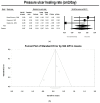Effectiveness of Hydrocolloid Dressings for Treating Pressure Ulcers in Adult Patients: A Systematic Review and Meta-Analysis
- PMID: 33121151
- PMCID: PMC7662705
- DOI: 10.3390/ijerph17217881
Effectiveness of Hydrocolloid Dressings for Treating Pressure Ulcers in Adult Patients: A Systematic Review and Meta-Analysis
Abstract
The aim of this study was to assess the effectiveness of hydrocolloid dressings in the treatment of grade I, II, III, and IV pressure ulcers in adult patients. We compared the therapeutic effects of hydrocolloids and alternative dressings in pressure ulcer treatment. We conducted a systematic review, using a literature search only in English, from database inception until 20 April 2020, to identify randomized trials comparing various types of dressings applied in the healing of pressure ulcers. The databases were PubMed, Embase, and Cumulative Index to Nursing and Allied Health Literature (CINAHL). The study selection was performed independently by two reviewers. Data were extracted based on the guidelines included in the Preferred Reporting Items for Systematic Reviews and Meta-Analyses (PRISMA) protocol. The risk of bias in the included studies was assessed using a standardized critical appraisal instrument developed by the Cochrane Collaboration. Random-effect meta-analysis of data from three or more studies was performed using meta-analysis software (Comprehensive Meta-Analysis V3, Biostat, New Jersey, USA). A total of 1145 records were identified, of which 223 were qualified after further verification, of which eight were finally included in further analysis. Hydrocolloid dressings were not superior to control therapeutics (p = 0.839; Z = 0.203; CI 95%: 0.791-1.334). They were not associated with higher healing rates (p = 0.718; Z = 0.361; OR: 0.067; CI 95%: 0.297-0.431), nor did they decrease the incidence of adverse events compared with control therapeutics (p = 0.300; Z = -1.036; OR: 0.067; CI 95%: 0.394-1.333). In the above cases, Egger's test also did not indicate publication bias (t value = 0.779, p = 0.465; t value = 1.198, p = 0.442; t value = 0.834, p = 0.465, respectively). The present meta-analysis shows that hydrocolloid dressings are not significantly better than alternative ones in the healing of pressure ulcers in adult patients.
Keywords: dressings; meta-analysis; pressure ulcer; systematic review; wound healing.
Conflict of interest statement
The authors declare no conflict of interest.
Figures




Similar articles
-
Foam dressings for treating pressure injuries in patients of any age in any care setting: An abridged Cochrane systematic review.Int J Nurs Stud. 2018 Nov;87:140-147. doi: 10.1016/j.ijnurstu.2018.07.012. Epub 2018 Jul 24. Int J Nurs Stud. 2018. PMID: 30118933
-
Multicenter randomized controlled trial comparing the effectiveness and safety of hydrocellular and hydrocolloid dressings for treatment of category II pressure ulcers in patients at primary and long-term care institutions.Int J Nurs Stud. 2019 Jun;94:179-185. doi: 10.1016/j.ijnurstu.2019.03.021. Epub 2019 Apr 4. Int J Nurs Stud. 2019. PMID: 31048187 Clinical Trial.
-
Effectiveness of moist dressings in wound healing after surgical suturing: A Bayesian network meta-analysis of randomised controlled trials.Int Wound J. 2023 Jan;20(1):69-78. doi: 10.1111/iwj.13839. Epub 2022 May 12. Int Wound J. 2023. PMID: 35546485 Free PMC article.
-
Sequential treatment with calcium alginate dressings and hydrocolloid dressings accelerates pressure ulcer healing in older subjects: a multicenter randomized trial of sequential versus nonsequential treatment with hydrocolloid dressings alone.J Am Geriatr Soc. 2002 Feb;50(2):269-74. doi: 10.1046/j.1532-5415.2002.50058.x. J Am Geriatr Soc. 2002. PMID: 12028208 Clinical Trial.
-
The application of moist dressings in wound care for tracheostomy patients: A meta-analysis.J Clin Nurs. 2019 Aug;28(15-16):2724-2731. doi: 10.1111/jocn.14885. Epub 2019 May 9. J Clin Nurs. 2019. PMID: 31002211
Cited by
-
The emerging progress on wound dressings and their application in clinic wound management.Heliyon. 2023 Nov 18;9(12):e22520. doi: 10.1016/j.heliyon.2023.e22520. eCollection 2023 Dec. Heliyon. 2023. PMID: 38076148 Free PMC article. Review.
-
In Vitro and In Vivo Characterization Methods for Evaluation of Modern Wound Dressings.Pharmaceutics. 2022 Dec 22;15(1):42. doi: 10.3390/pharmaceutics15010042. Pharmaceutics. 2022. PMID: 36678671 Free PMC article. Review.
-
Antimicrobial Smart Dressings for Combating Antibiotic Resistance in Wound Care.Pharmaceuticals (Basel). 2025 May 30;18(6):825. doi: 10.3390/ph18060825. Pharmaceuticals (Basel). 2025. PMID: 40573221 Free PMC article. Review.
-
Effect of hydrocolloid dressings in the management of different grades of pressure wound ulcers in critically ill adult subjects: A meta-analysis.Int Wound J. 2023 Dec;20(10):3981-3989. doi: 10.1111/iwj.14286. Epub 2023 Jul 11. Int Wound J. 2023. Retraction in: Int Wound J. 2025 Jan;22(1):e70189. doi: 10.1111/iwj.70189. PMID: 37434335 Free PMC article. Retracted.
-
Streamlining Skin Regeneration: A Ready-To-Use Silk Bilayer Wound Dressing.Gels. 2024 Jun 30;10(7):439. doi: 10.3390/gels10070439. Gels. 2024. PMID: 39057462 Free PMC article.
References
-
- National Pressure Ulcer Advisory Panel . European Pressure Ulcer Advisory Panel and Pan Pacific Pressure Injury Alliance (NPUAP/EPUAP/PPPIA) In: Emily H., editor. Prevention and Treatment of Pressure Ulcers: Quick Reference Guide. Cambridge Media; Osborne Park, Australia: 2014.
-
- Pieper B. Pressure Ulcers: Prevalence, Incidence, and Implications for the Future. National Pressure Ulcer Advisory Panel; Washington, DC, USA: 2013.
-
- Pelham F., Keith M., Smith A., Williams D.V., Powell G. Pressure ulcer prevalence and cost in the U.S. population. J. Am. Med. Direct. Assoc. 2007;8:B20. doi: 10.1016/j.jamda.2007.01.090. - DOI
Publication types
MeSH terms
LinkOut - more resources
Full Text Sources
Medical
Miscellaneous

